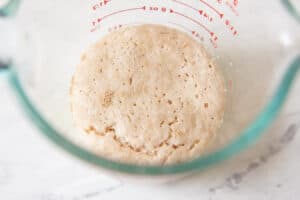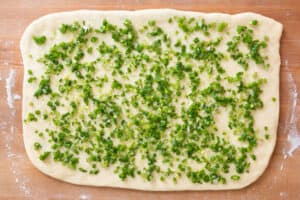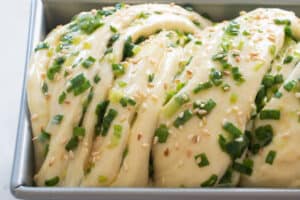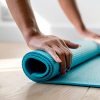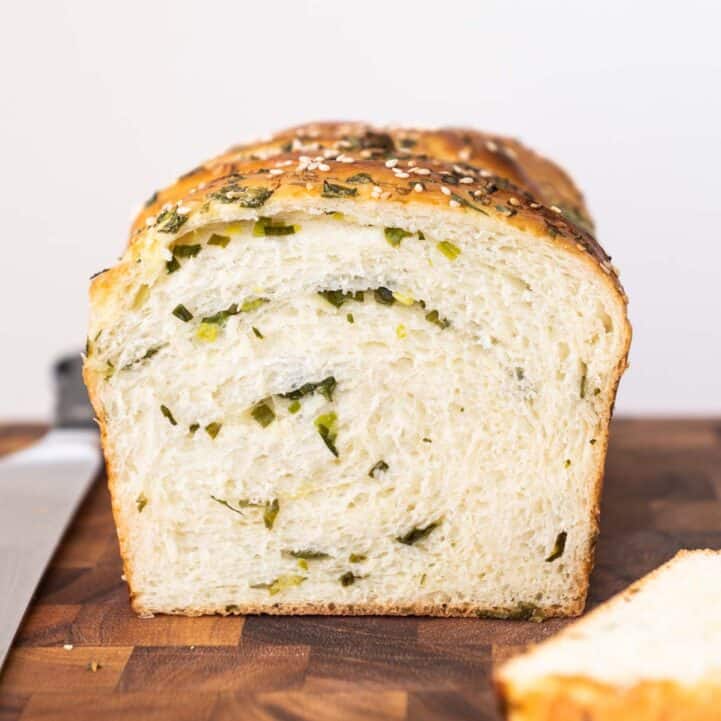
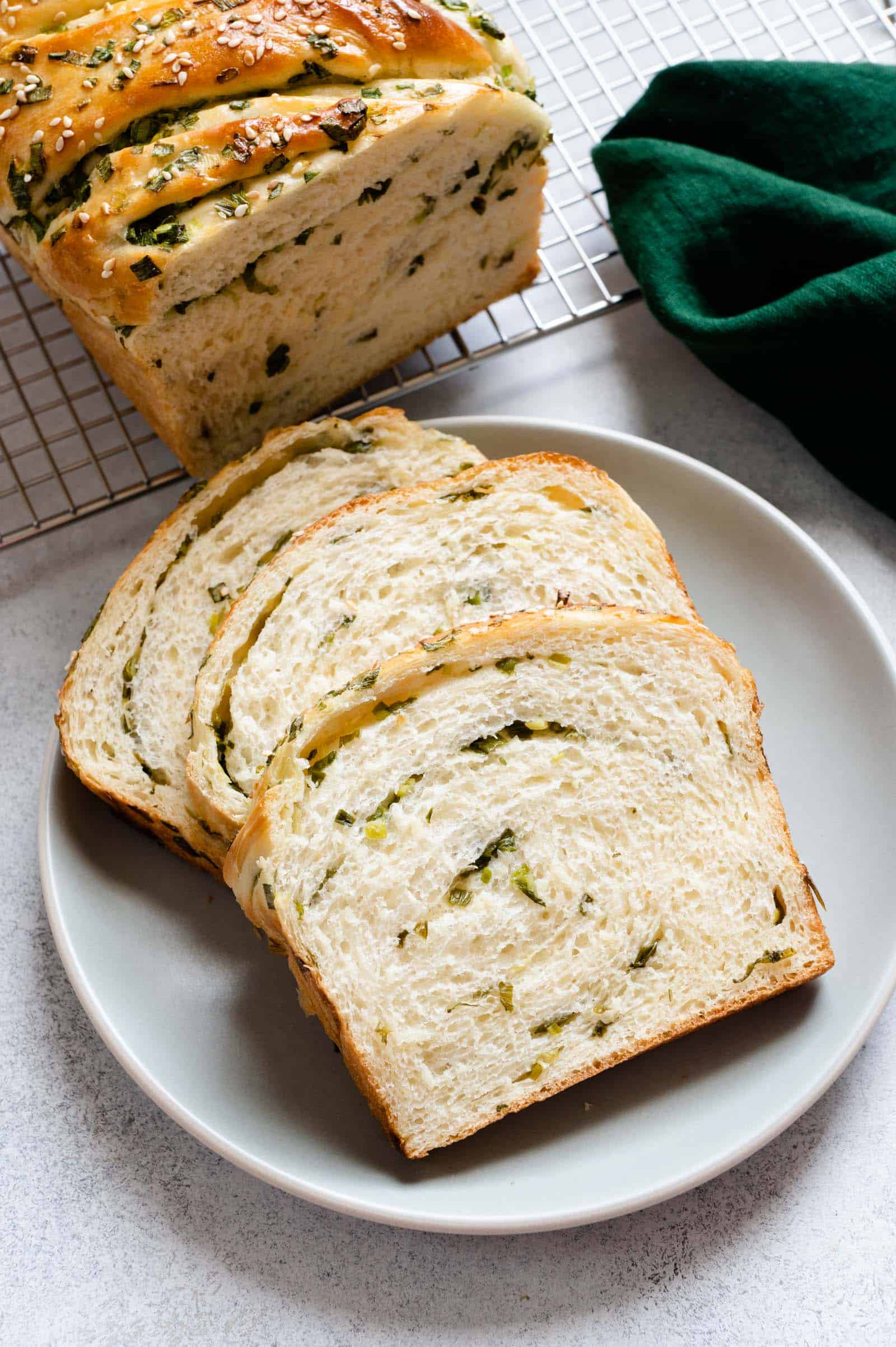
I’m proud to say that my family loves my baked scallion bread (蔥油麵包) because it reminds them of Asian bakery bread. That scallion bread is one of my favorites, too. For the past year, I’ve been trying to adapt the recipe by baking the bread in a loaf pan instead of shaping two large twisted loaves. That way, I can enjoy the bread on its own or slice it up for toast and sandwiches. I baked this scallion milk bread for my family a few times now, and it gets their seal of approval!
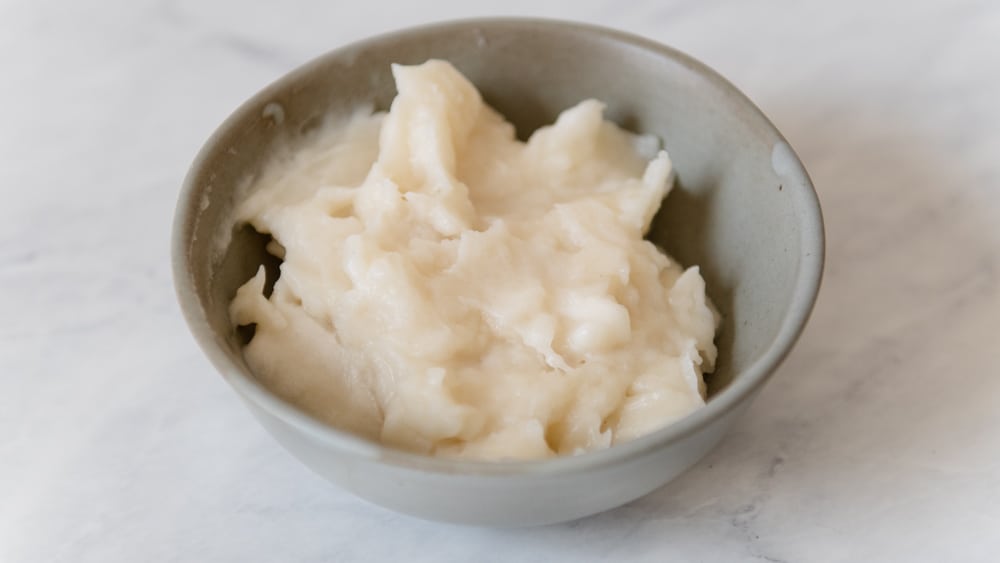
TANGZHONG: THE KEY TO A SOFT LOAF
What I love most about this bread is its soft and feathery interior. To get this incredibly airy crumb, I add tangzhong (湯種) to the dough. Tangzhong is a Chinese technique of heating flour and water together to form a paste that is then added to the dough. The paste allows more water to be absorbed into the flour, yielding bread with softer texture. Not only is the bread soft the day it’s baked, but the crumb stays soft a few days later too!
TESTING THE SCALLION MILK BREAD
To develop this recipe, I adapted my Japanese milk bread and baked scallion bread recipes. As I tested this recipe, I tried shaping the loaf in many ways. I wanted to shape the bread like a babka because I love how the twists look at the top of the loaf. But after baking the bread a few times, I found the distribution of the scallion filling very inconsistent. Most of the time, the scallion filling ended up on the top of the loaf with a few tiny scatterings of scallions in the center.

Next, I tried shaping the dough like a cinnamon swirl loaf with the scallion filling swirled inside. That didn’t work either because the center of the bread collapsed as it cooled. Because there was so much scallion filling in the center, the inner swirl couldn’t cling onto the exterior of the bread completely. As a result, there were large holes in the interior of the bread.

Finally, I decided to add the scallion filling to the bread in 2 additions. Essentially, I rolled out the dough into a rectangle once and spread half of the filling over the dough. Then, I fold it up, roll the dough into a rectangle again, spread the remaining filling, and shape the loaf like a babka. This final method of shaping the scallion milk bread yielded the best results. The scallion filling was much more evenly distributed.
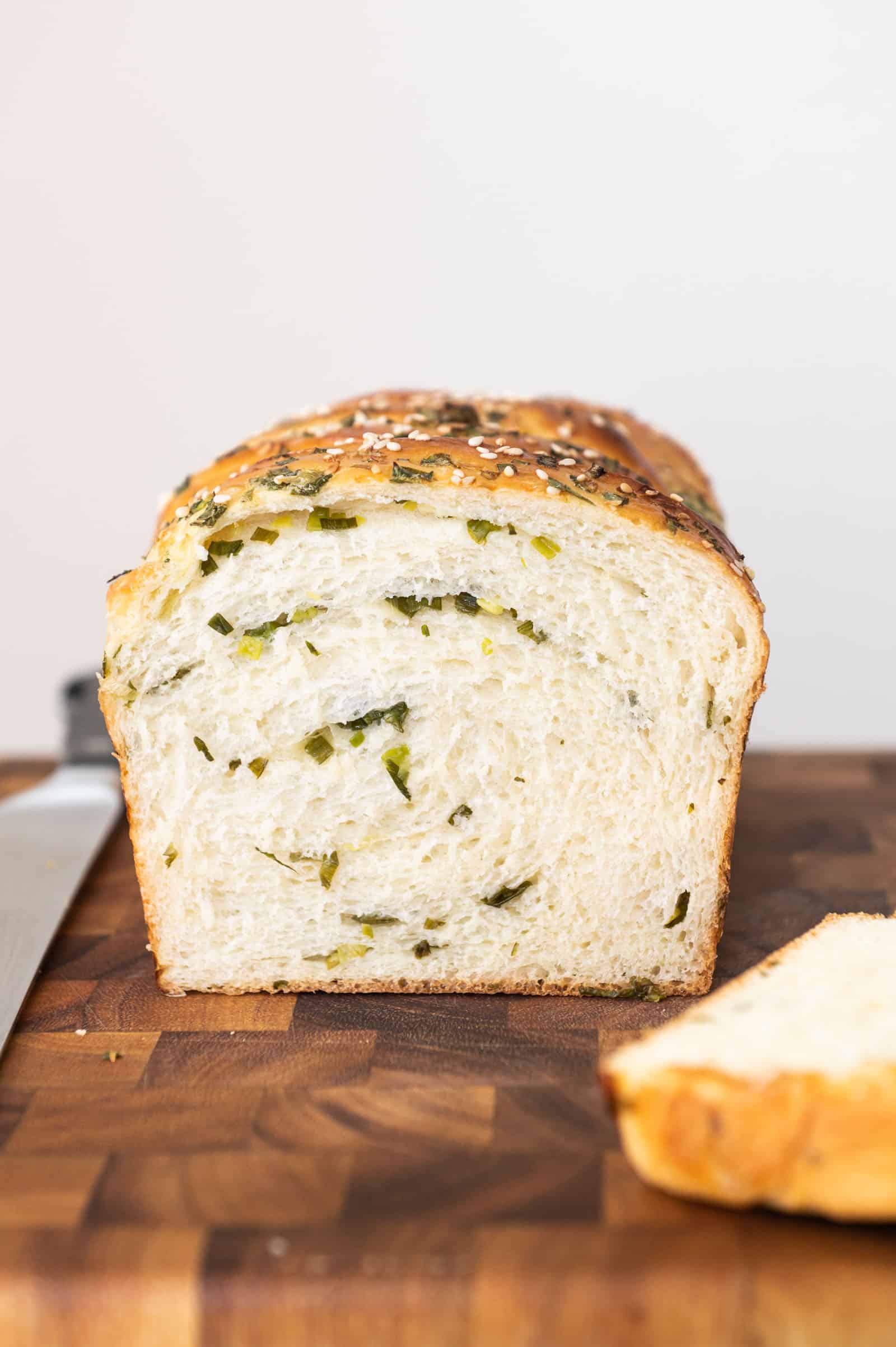
CAN I KNEAD THE DOUGH BY HAND?
Typically, I use my stand mixer to work the dough because it feels very wet at the beginning. However, it is possible to knead the dough by hand; it will take more time and be a messier process.
Once you’ve made the tangzhong and activated the yeast, add all the ingredients for the dough in a bowl. Using a wooden spoon, mix everything together until it looks like all the liquids have absorbed into the flour (see photo below).
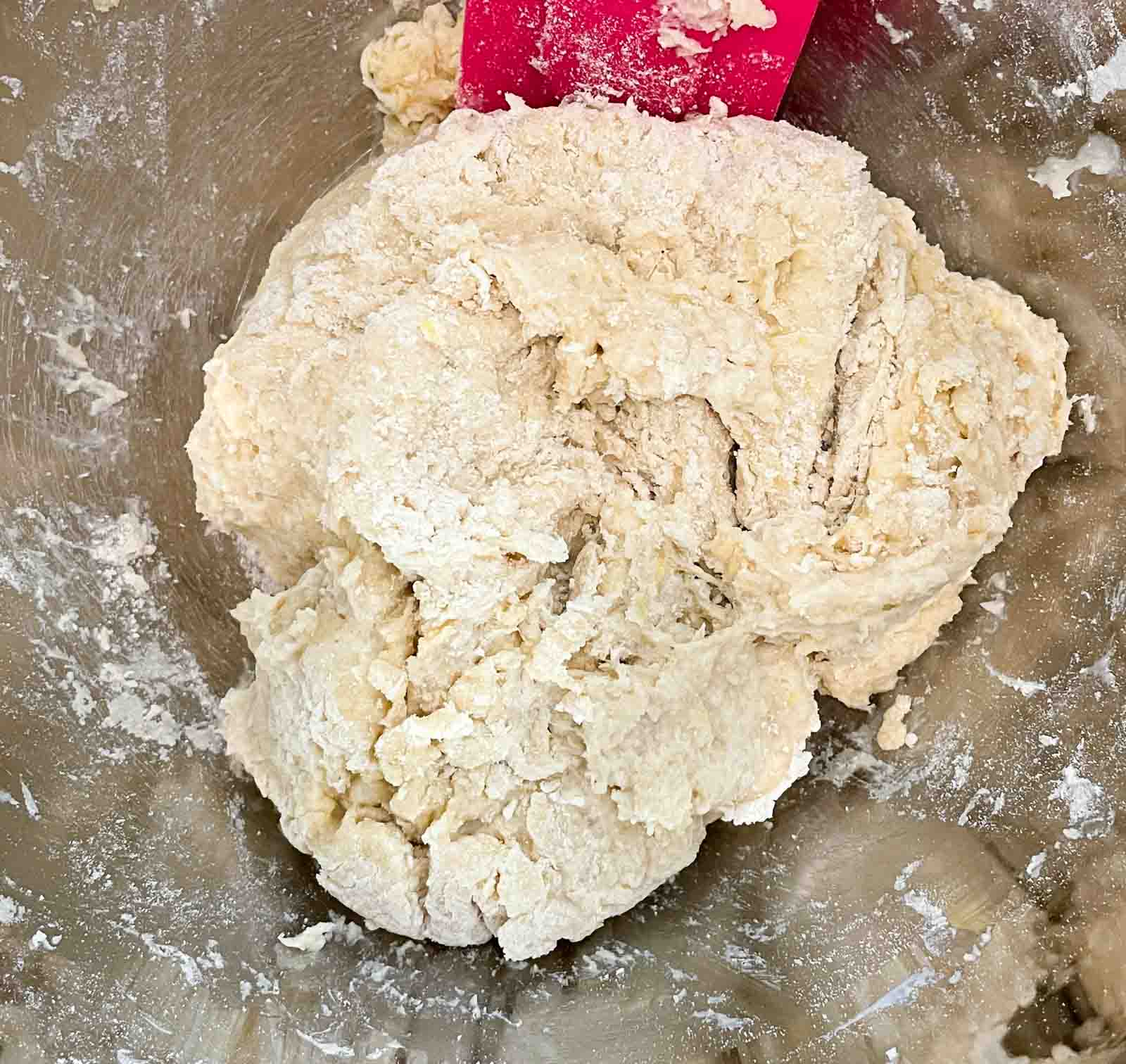
Lightly dust the work surface with flour. Have a bench scraper ready to scrape wet dough off the counter.
Transfer the dough onto the floured surface. Knead it a few times. Then grab onto the bottom half of the dough and stretch it towards you. Fold it over the other half. Repeat the stretch and fold process for several minutes. Use the bench scraper to scrape off dough that’s stuck to the work surface. It won’t be easy at the start because the dough is very wet and sticks to your fingers. Just keep going as best you can.
After a few minutes, grab all the dough, slap it on the counter, stretch it towards you, and fold it over. Repeat this process until the dough no longer feels like it’s really sticky on your hands.
When kneading dough by hand, don’t pay attention to how long you’re kneading the dough. Rather, focus on how the dough feels. By the end, the dough will feel slightly tacky but not overly sticky.
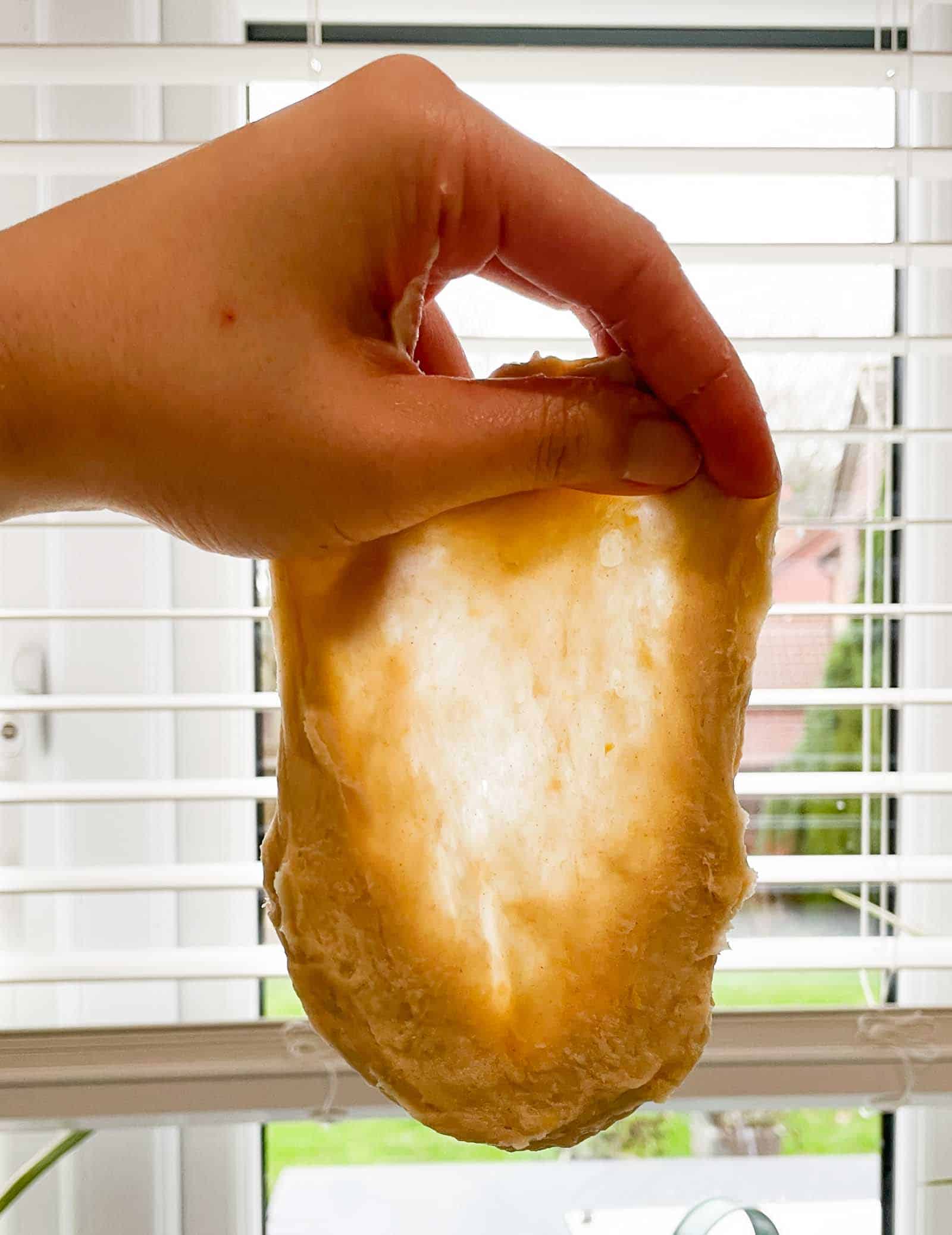
Finally, do the window pane test to make sure the gluten has been properly developed. Take a golf-ball size of dough and stretch out the center of the piece of dough. If the dough stretches out to a thin layer and light is coming through, the dough is ready for the first rise.
CAN I MAKE THE DOUGH AHEAD?
Yes! Right after you knead the dough in the mixer or by hand, place the dough in a greased bowl, cover, and let it rise overnight. When you are ready to bake the next day, just shape the dough directly out of the fridge. You don’t need to let it reach room temperature first.

MORE BREAD RECIPES
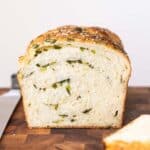
Scallion Milk Bread
The dough is enriched with fat and sugar, so the second rise will take time: 1 1/2 to 2 hours (it’s usually 2 hours for me during the fall/winter). If you bake an underproofed loaf, there will be a lot of small tears throughout the bread. It’s not the end of the world–the bread just won’t look as nice.
Ingredients
Tangzhong
- 2 tablespoons (20g) bread flour (see note 1)
- 1/3 cup (75g/78mL) water
Dough
- oil for greasing bowl any oil works
- 1/2 cup (115g/118mL) whole milk
- 4 tablespoons (50g) sugar
- 1 1/2 teaspoons (5g) active dry yeast
- 2 3/4 cup (330g) bread flour (see note 2)
- 1 tablespoon (10g) instant milk powder (see note 3)
- 1 teaspoon (4g) Diamond Crystal kosher salt or sub with 1/2 teaspoon sea salt
- 4 tablespoons (55g) unsalted butter melted and cooled slightly
- 1 large egg
Scallion Filling
- 1 1/3 cup (90g) sliced scallions
- 3/4 teaspoon (3g) Diamond Crystal kosher salt or sub with 3/8 teaspoon sea salt
- 1 tablespoon sesame oil
Topping
- 1 egg
- 1 tablespoon milk
- 1 to 2 tablespoons toasted sesame seeds
Special Equipment (some links below are affiliate links)
- large mixing bowl
- thermometer
- stand mixer
- 9×5-inch loaf pan (see note 4)
- rolling pin
- brush for egg wash
- cooling rack
Instructions
Make Tangzhong
-
You can make the tangzhong in a saucepan or the microwave. For the saucepan method, whisk the flour and water together until the flour dissolves. Place the saucepan over medium heat and stir the mixture frequently. In about 30 seconds to 1 minute, the flour will start to thicken. Stir constantly until the watery liquid absorbs into a thicker paste. Turn off the heat and transfer the tangzhong to a bowl to cool.

-
For the microwave method, whisk the flour and water together in a microwave-safe bowl. Then, heat the mixture for 30 seconds on high. Take the bowl out of the microwave, stir everything and check the consistency of the mixture. If it has started to form into a paste, stir everything and let cool. Otherwise, heat the mixture at 5-second intervals, stirring in between, until you get a thick paste. Try not to overheat the tangzhong in the microwave because it can turn into a solid, stiff paste.
Prepare Dough
-
Lightly grease a large mixing bowl with oil and set it aside.
-
In a microwave-safe bowl, heat the milk in the microwave on high for about 30 to 40 seconds. Use a thermometer to check the temperature of the milk. It should be somewhere around 105ºF to 120ºF. If the milk isn’t hot enough yet, heat it again for 5 to 10 seconds. If the milk is too hot, quickly whisk the milk and let it cool for several minutes. If you don’t have a thermometer, use your fingers to test the temperature. The milk should feel very warm but not scalding hot either.
-
Add the sugar and yeast to the milk. Stir to hydrate the yeast. Let it sit for 5 to 8 minutes while you prepare the other ingredients. After 5 to 8 minutes, you should see a layer of foam on the top, at least 1/4 inch thick (an indication that the yeast is active).

-
In the bowl of a stand mixer, add the flour, tangzhong, milk/yeast mixture, instant milk powder, salt, melted butter, and egg.

-
Fit the mixer with the dough hook. Mix the dough on low until you don’t see any loose flour on the sides of the bowl. This should take 30 seconds to 1 minute.

-
Then, increase the speed to medium-low and work the dough for 8 minutes. You may need to scrape down the sides of the bowl occasionally.
-
Scrape the dough out of the bowl onto a lightly floured surface and knead a few times. If the dough is feeling tacky, lightly sprinkle flour over the dough and knead a few times.
-
Shape the dough into a ball and place inside the greased mixing bowl. Cover the bowl with a damp towel (or a silicone lid) and let it rise in a warm place for about 1 hour, until the dough doubles in size.

Prepare Filling
-
About 5 to 10 minutes before you’re ready to shape the loaf, mix the sliced scallions with salt and sesame oil. Set the bowl aside and let the scallions soften slightly.

Shape Loaf
-
Punch down the risen dough to release excess air. Turn the dough onto a lightly floured surface.

-
Roll the dough out into a 14×10-inch rectangle. Spread half of the scallion filling over half of the rolled out rectangle. Fold the side of the dough without scallions over the other half, like a book.

-
Rotate the folded dough 90º and roll out the dough again into a 14×10-inch rectangle. If the dough is sticking to the rolling pin or work surface, lightly sprinkle flour above/below the dough.
-
Spread the remaining scallion filling over the entire surface of the rolled out dough.

-
Grab onto a long edge of the dough rectangle and start rolling up the dough into a log. Measure the log and try to make sure it’s about 14 inches long. If it’s any longer, squish the ends together to shorten the log.

-
Using a sharp knife, make a long cut along the length of the dough log to cut it in half. I highly recommend using a long bread knife, if you have one. Try to work quickly as you slice the log, as it unfurls quickly due to the volume of scallion filling inside.

-
Cross one strand of the dough over the other at the center.

-
On one end, twist the dough strands over each other twice. Do the same thing to the dough strands on the other end, until you have a twisted loaf.

-
Transfer the twisted loaf to the loaf pan.

-
Cover the loaf pan loosely with plastic wrap and let the dough rise for 1 1/2 to 2 hours, until the dough has risen about 1 to 1.5 inches over the rim of the loaf pan. It usually takes 2 hours for me. The dough should feel quite puffy when you press it gently.

Bake Bread
-
Towards the end of the second resting period, preheat the oven to 350ºF (175ºC). Position an oven rack to the center.
-
Whisk an egg with 1 tablespoon of milk for the egg wash. Gently brush a thin layer of egg wash over the loaf. Try not to drench the loaf with egg wash, as the egg can cause the bread to stick to the sides of the loaf pan. Sprinkle toasted sesame seeds over the loaf generously.

-
Bake the bread for 26 to 28 minutes, until the top is a deep golden brown. Remove the bread from the oven and let it cool in the pan for 5 minutes.
-
Then, turn the bread out onto a cooling rack. I don’t like to let the bread cool in the pan because I find condensation can develop inside the pan, making the bread wet. If the baked egg wash is causing the loaf to stick to the pan, gently use your fingers to press the loaf away from the pan to release it. Let the loaf cool for at least 20 to 30 minutes before slicing and serving.

-
Store any leftovers in an airtight container at room temperature for 3 to 4 days.
Notes
- I have made this recipe using all-purpose flour instead of bread flour, and it works, too. The bread has a slightly less chewy consistency.
- This volume measurement comes from the spoon-and-sweep method of measuring flour.
- I add instant milk powder to give the bread a milky flavor. You can leave it out if it’s difficult to source.
- If you’re using an older pan, one that has issues with bread sticking to the edges, grease the loaf pan. Then, line the long side of the pan with parchment paper.
Nutrition
The post Scallion Milk Bread appeared first on Healthy Nibbles by Lisa Lin.


